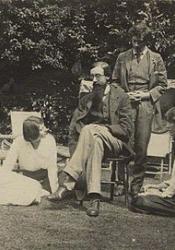Novels and Influence from the Bloomsbury Group
Our class was introduced to the Bloomsbury Group through our discussions about Virginia Woolf and her works, but Woolf is not the only influential artist to have participated in the history of this literary setting. This group was made up of other famous writers such as Lytton Starchey and E. M. Forrester, and was founded around the year 1905, though it was not coined its current name until 1912 "when Vanessa Bell, Duncan Grant and other artist friends showed their work at an exhibition, the Second Post-Impressionist Exhibition, organised in London by their art critic friend Roger Fry" ("Lifestyle and Legacy..."). This group hosted artists like Duncan Grant and Henry Lamb as well as writers, and the original group meetings were actually held at Vanessa and her brother's home in London. Thursday and Friday meeting times were established, the first being for the writers and the latter for the artists, where a whole range of topics were discussed such as philosophy, art, and the member's own creative opinions. It is the variety of opinions from this colorful group of people that has persistently left people fascinated with the Bloomsbury Group, preserving its significance and identity in the literary world. Discussing the hallmark novels from this bunch of creators bears connections to the formation of the novel as a genre. Lytton Strachey’s Eminent Victorians (1918) has set an interesting standard for biographies in his intricate examination of four very influential Victorian figures. John Maynard Keynes’s Economic Consequences of the Peace (1919) approached the tumultuous topic of peace in post-WWI Europe, expanding conversations in the literature related to war and peace for years to come. Virginia Woolf’s works have very obviously made impacts on the formation of the novel genre in how modern readers still turn to her artistry for inspiration and textual evidence for relevant discussions and debates. Her 1925 novel Mrs. Dalloway also examines a post-war perspective of a certain bunch of characters, adding to the influence of literary conversations and responses to the devastations of war within the mode of novel writing. Over the years, these artists' legacies have been met with criticism concerning unoriginal work, despite their works having "mixed with important European avant-garde artists, writers and musicians" ("Lifestyle and Legacy..."). The drama surrounding these creatives' views on sex and relationships also attracted critics and curious onlookers. The group members, "are often better known for their unconventional personalities and lifestyles than for their art" ("Lifestyle and Legacy..."), having come from "wealthy backgrounds, which had given them social advantages and self-confidence" ("Lifestyle and Legacy..."). However, their main spark of inspiration seems to be connected to, "a spirit of rebellion against what they saw as the unnecessary conventions, restraints and double standards of their parents’ generation" ("Lifestyle and Legacy..."). As a result, one may question how successful they were in their spirited endeavors. Focusing on Woolf alone is a testament to at least some relevancy having resulted from the formation of this community, as well as Roger Fry's contributions towards art and his book, Vision and Design (1920), which, "did much to shape the development of modernism" ("Lifestyle and Legacy..."). The London Artists Association also has this artistic camaraderie to thank for its formation to help in "provid[ing] artists with a means of selling their work" ("Lifestyle and Legacy..."). All in all, this group of people contributed to the academic and artistic community through their interaction in society as well as their linguistic and visual art. One could even claim that they are an early model for what present-day writing and art groups look like. Though the devastation of WWI prevented a long history for the meetings, this group's cultivation of the arts not only impacted its outside environment on a grand scale but cultivated the minds of its members, in turn impacting not only the genre of the novel but the formation of other impacting art styles and artists in more than just the central London area.
“Lifestyle and Legacy of the Bloomsbury Group – Look Closer.” Tate, www.tate.org.uk/art/art-terms/b/bloomsbury/lifestyle-lives-and-legacy-bl....

